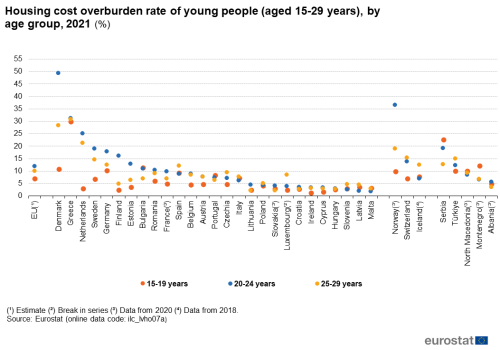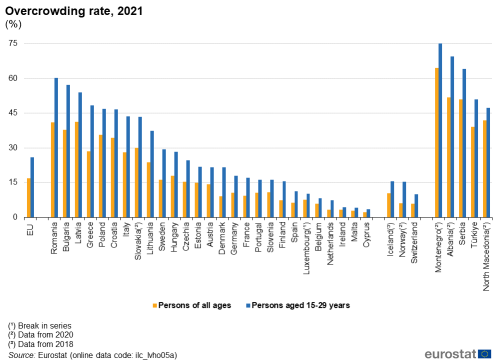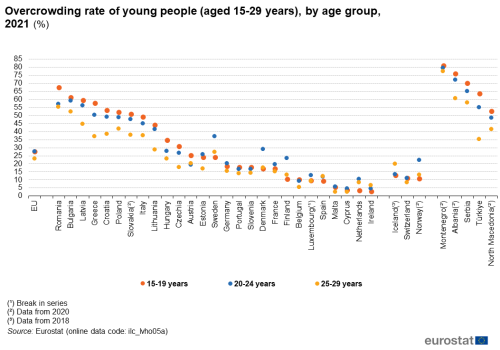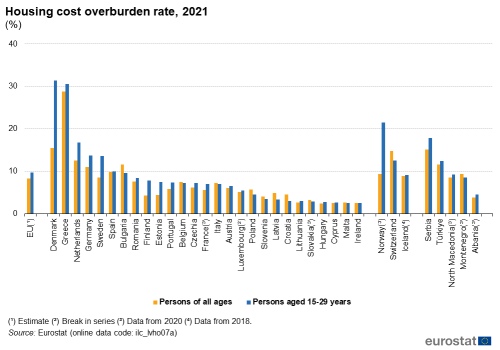Young people - housing conditions
Data extracted in May 2023.
Planned article update: September 2024.
Highlights
In 2021, 26 % of young people (aged 15-29 years) in the EU lived in overcrowded households, which is 9 percentage points higher than in the total population.
In 2021, in 21 Member States youngsters aged between 15 and 19 were most likely to live in an overcrowded household.
In 2021, 9.7 % of young people (aged 15-29 years) in the EU lived in households that spent 40 % or more of their equivalised disposable income on housing, 1.4 percentage points more than the total population.
Overcrowding rate, 2021
This article analyses the housing conditions of young people (persons aged 15-29 years — both living with their parents and independently) in the European Union (EU), looking at two important aspects:
A separate Statistics Explained article on housing conditions and affordability analyses the situation for the total population.
Full article
Key findings
In 2021, there were 73 million young people aged between 15 and 29 (16.3 % of the whole population) in the EU[1], and, as in many other aspects in life, they can face challenges in housing. The share of young people living in overcrowded households is 9 percentage points (p.p.) higher than for the total population. In some countries the difference is even greater: it reaches 19.9 p.p. in Greece and 19.3 p.p. in Romania and Bulgaria. The highest percentage of young people living in overcrowded households is in Romania (60.3 %), Bulgaria (57.2 %), Latvia (53.9 %) and Greece (48.4 %). In these countries, as well as 17 other Member States, youngsters aged between 15 and 19 were most likely to live in overcrowded households.
Young people are also in a more disadvantaged position than the population as a whole concerning the share of income spent on housing: 9.7 % of young people, that is 1.4 p.p. more than the whole population, spent 40 % or more of their equivalised disposable income on housing. This housing cost overburden rate for young people was the highest in Denmark (31.4 %) and Greece (30.6 %) in 2021.
Overcrowding rate
In 2021, 26.0 % of young people (aged 15-29 years) in the EU lived in overcrowded dwellings
The overcrowding rate is defined as the percentage of the population living in an overcrowded household. A person is considered as living in an overcrowded household if the household does not have at its disposal a minimum number of rooms equal to the sum of:
- one room for the household;
- one room per couple in the household;
- one room per single person aged 18 and more;
- one room per pair of single people of the same gender between 12 and 17 years of age;
- one room per single person between 12 and 17 years of age and not included in the previous category;
- one room per pair of children under 12 years of age.
In 2021, the overcrowding rate for young people stood at 26.0 %, 1.5 p.p. lower than in 2020. Across all EU, EFTA and EU candidate countries young people were more likely than the overall population to live in overcrowded households. The overcrowding rate for young people was 9.0 p.p. higher than the overcrowding rate for the population as a whole (17.0 %).
There are considerable differences in overcrowding rates between Member States. In Cyprus, 3.6 % of young people lived in an overcrowded household in 2021, while in Romania the rate reached 60.3 %. More than half of young people also lived in overcrowded households in Bulgaria and Latvia, and more than a third of the young population in Greece, Poland, Croatia, Italy, Slovakia and Lithuania (see Figure 1). Greece observed the highest difference in p.p. (19.9 p.p.) between the overcrowding rate for the 15-29 years age group (48.4 %) and the population as a whole (28.5 %). Bulgaria and Romania both recorded a 19.3 p.p. difference. In relative terms, the largest differences were observed in Denmark, the Netherlands and Finland, where the overcrowding rate for young people was more than twice as high as the rate for the population as a whole.
Regarding EFTA countries, Norway had the same pattern as Denmark, the Netherlands and Finland: the overcrowding rate for young people was 15.3 % compared to 6.2 % for the total population, 9.1 p.p. or 2.5 times more.
Iceland recorded a 15.6 % overcrowding rate for young people (5.2 p.p. more than for the total population) and Switzerland recorded a rate of 9.9 % (4.1 p.p. higher than for the total population).
The overcrowding rate for youngsters in the EU candidate countries ranged from 76.8 % in Montenegro to 47.2 % in North Macedonia.
Figure 2 presents the overcrowding rate for young people broken down by age groups of 15-19, 20-24 and 25-29 year olds. Generally, in countries where the overcrowding rate for young people is high, the group of 15-19 year olds is the most affected. In Romania, Bulgaria, Latvia and Greece more than half of 15-19 year olds live in overcrowded households (ranging from 67.4 % in Romania to 57.7 %. in Greece). In most Member States in which the overcrowding rate is rather high for young people, the rate diminishes with age. The biggest difference between 15-19 and 25-29 year olds is seen in Greece (20.8 p.p.) followed by Lithuania (15.4 p.p.), Latvia and Croatia (14.9 p.p. in both).
Sweden, Denmark and Finland, as well as Norway seem to present a different pattern for this indicator. In those countries, living in an overcrowded home is an issue more often in the group of 20-24 year olds. The difference with the next age group (15-19 year olds) is 12.8 p.p. in Sweden, 12.7 p.p. in Finland, 12.0 p.p. in Denmark and 11.2 p.p. in Norway. In Finland and Norway, the overcrowding rate of 20-24 year olds is more than twice as high as that of the 15-19 year olds and even higher compared to the age group of 25-29 year olds. In other countries where the overcrowding rate is lower, the differences among age groups are smaller.
Among EU candidate countries, the greatest differences or overcrowding rates between age groups were found in Turkey.
Housing cost overburden rate
In 2021, 9.7 % of young people (aged 15-29 years) in the EU lived in households that spent 40 % or more of their equivalised disposable income on housing. This figure is 1.4 p.p. higher than for the total population.
The indicator housing cost overburden rate shows the percentage of the population living in households where housing costs equate to more than 40 % of a household’s disposable income.
In 2021, 8.3 % of the population in the EU lived in households that spent 40 % or more of their equivalised disposable income on housing (see Figure 3). For young people the share was 1.4 p.p. higher, at 9.7 %. However, there are considerable differences between Member States. Ireland had the lowest housing cost overburden rate for young people (2.5 %), while Denmark (31.4 %) and Greece (30.6 %) had by far the highest. Six Member States recorded rates above the EU average (9.7 %).
In 17 EU Member States, the housing cost overburden rate in 2021 was higher among the population aged 15-29 years than for the population as a whole. The difference of 15.9 p.p. in Denmark was far greater than in any of the other Member States, as the second largest difference was 5.1 p.p. in Sweden. In relative terms as well, the difference was greatest in Denmark. The housing cost overburden rate for young people was twice as high as for the whole population (2.0 times), although this was only slightly greater than the relative differences observed in Finland (1.8 times), Estonia (1.7 times) and Sweden (1.6 times).
Unlike the overcrowding rate, some EU Member States recorded (slightly) higher housing cost overburden rates for the population as a whole than for young people. This was the case in nine Member States. Among these Member States, Bulgaria recorded the largest difference (2.0 p.p.), with 11.6 % of the population as a whole having a housing cost overburden compared with 9.6 % for the younger population.
Among the EFTA countries, Norway also recorded a large difference (12.1 p.p.). The relative difference was greatest in Norway (among all analyzed countries), with the rate for young people (21.5 %) some 2.3 times higher than the population as a whole (9.4 %). Switzerland on the other hand was in the situation where the overburden rate for the overall population was higher than that for young people. (with a difference of 2.3 p.p.).
Both the EFTA and the EU candidate countries were characterized by housing cost overburden rates above the EU average, with the exception of Albania.
Figure 4 analyses the situation further broken down to 15-19, 20-24 and 25-29 year olds. Among these, the housing cost overburden rate was highest for 20-24 year olds (11.9 %) and lowest for 15-19 year olds (7.1 %). This was the case in most of the Member States.
The degree of difference however varied. Denmark, the Netherlands, Sweden, Finland and Estonia, as well as Norway (among EFTA countries) presented the most notable differences between the age groups. In all of these countries, the biggest burden falls on 20-24 year olds, followed by 25-29 year olds and finally 15-19 year olds.
Switzerland and Iceland followed a slightly different pattern: 25-29 year olds were the most affected by housing cost overburden.
Among the EU candidate countries, in Serbia and Montenegro the 15-19 year olds had the highest housing cost overburden rate. In Turkey the rate was highest for 25-29 year olds. On the other hand, in North Macedonia and Albania the difference between these age groups was smaller.

(%)
Source: Eurostat (ilc_lvho07a)
Source data for tables and graphs
Data sources
The data used in this article are primarily derived from EU statistics on income and living conditions (EU-SILC). The legal basis for these data is Regulation (EU) 1700/2019 that establishes a common framework for European statistics relating to persons and households, based on data at individual level collected from samples. EU-SILC is the main European source of information for statistics relating to income, living conditions and social inclusion. The reference population covered by these data is all private households and their current members residing in the territory of an EU Member State, EFTA countries and EU candidate countries at the time of data collection. Persons living in collective households and in institutions are generally excluded from the target population. The EU aggregate is a population-weighted average of individual national figures.
Context
Housing conditions are a fundamental aspect of living standards and social integration of individuals. For young people starting life away from the parental household, finding and sustaining accommodation can be a major challenge. In the EU’s European Pillar for Social Rights Action Plan, one of the headline targets is: ‘lifting at least 15 million people out of the risk of poverty and social exclusion by 2030’. For each target a group of indicators was set up to monitor and support the strategy. Housing conditions are included within the indicators related to material deprivation. Housing issues are also addressed in the new EU youth strategy adopted for the period from 2019 to 2027.
Direct access to
Theme entry page
Online publications
Statistical articles
- Children at-risk-of-poverty or social exclusion
- Living conditions in Europe — housing
- Living conditions in Europe — material deprivation and economic strain
- Material deprivation statistics — early results
- Migrant integration statistics — housing
- Living conditions in Europe - poverty and social exclusion
- Youth (yth), see:
- Youth social inclusion (yth_incl)
- Living conditions (ilc_lv)
- Housing conditions (ilc_lvho)
- Material deprivation (ilc_md)
- Housing deprivation (ilc_mdho)
- Living conditions (ilc_lv)
- Income and living conditions (ESMS metadata file — ilc_esms)
- ↑ According to Eurostat’s demographic data: Child and youth population on 1 January by sex and age [YTH_DEMO_010__custom_2164673]


